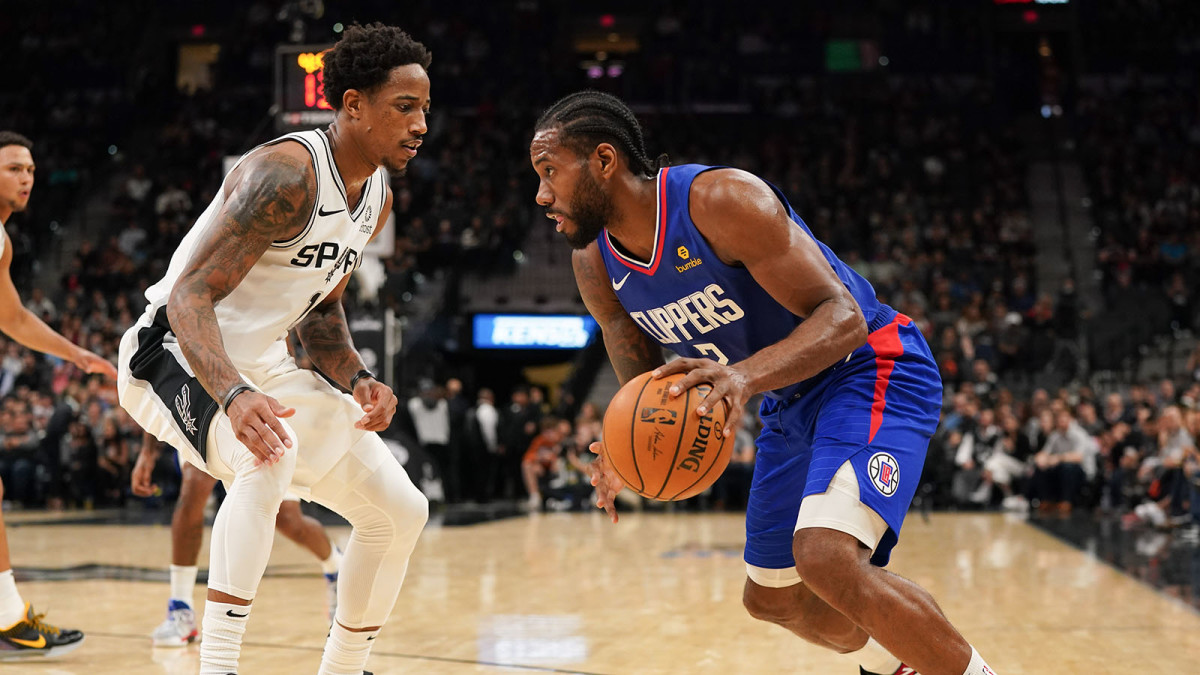Spurs’ Defensive Woes Are Threatening Playoff Streak


The last time the San Antonio Spurs posted a team defensive rating higher than that of their offensive rating, the year was 1997, Gregg Popovich had just completed his first (and only) season as interim head coach, the leading scorer was a 37-year old Dominique Wilkins and the Spurs finished sixth in the now-defunct Midwest Division of the Western Conference at 20-62.
That was also the last season San Antonio missed the playoffs, as they are currently tied with the Syracuse Nationals/Philadelphia 76ers (1950-1971) for the longest postseason appearance streak in NBA history at 22 years. Obviously, Popovich stuck around in the head coaching role throughout the run, tallying five championships along the way. But after an 8-14 start to the 2019-20 season with an underpowered and aging core as well as a highly competitive Western Conference to compete against, it appears the streak has a good chance to end. However, it’s the Spurs; they’ve been the most consistently good team in the NBA for the past two decades, and counting them out of the chase at the start of December would be an oversight.
But something is wrong in San Antonio, and it’s the defense. The team defensive rating sits at 113.8, 27th in the league and three-and-a-half points higher than their halfway-decent 109.8 offensive rating (12). That’s a worse defensive rating mark than the 112.0 total that the ’96-’97 Spurs posted (to be fair, across 82 games). On the surface, poor defense seems to be the main issue holding this San Antonio squad back, an unusual anecdote for a Popovich team one would expect to be systematically sound and tenacious defensively despite its shortage of “stars.”
Throwing the numbers under a microscope reveals some more indicators that San Antonio must clean up its defense if it hopes to keep the streak alive. The weak points appear to be in one-on-one matchups; opposing teams are shooting 47.8% on defended attempts against the Spurs, good for 27th in the league. Those issues blanket both the outside (opponents shooting 39.1% on defended threes, third worst) and inside, where teams are making 30.5 defended twos per game against San Antonio (fourth worst). Effectively stopping jump shooters has also been a cold sore, as the Spurs are allowing opponents to shoot 42.2% on spot-up jumpers (second worst) and score on such attempts 42.2% of the time (league-worst). Quite simply, individual San Antonio defenders aren’t effectively contesting jumpers or preventing opposing players from getting to their spots, and the barrage of outside shots led to losses in games where the Spurs scored 132, 116 and 115 points.
But the other noticeable area of concern for San Antonio is another unexpected issue for a Popovich team–hustle. Again, “hustle” can be hard to define and quantify, but since NBA.com can, we can too. The Spurs are struggling to do the little things that were once hallmarks of their system, sitting 24th in deflections per game (13.5), 23rd in defensive loose balls recovered (3.7/game) and in the 20s in most box-out categories. Though perhaps not directly correlated, San Antonio’s transition D is similarly poor. They are the worst defensive team in the NBA in those situations, sitting in the 0.0 percentile at 1.19 points allowed per (transition) play and with opponents shooting 58.9%.
To be fair to Pop, San Antonio’s players have not done him any favors. Every Spur that has played at least nine games this season is sporting a defensive rating that is either a career-worst or tied for their career-worst. Murray and Jakob Poetl are the only players under 110 on the season, and reliable defenders like LaMarcus Aldridge (106 career) and Rudy Gay (108) are sitting at 113 and 114 respectively. Even longtime Spur Paddy Mills, who sported a 105 rating from 2011-16, has ballooned up 116 in 2019-20. On an individual level, San Antonio just isn’t winning the defensive battles they need to keep opponents in check and start converting some of those high point totals into wins.
So, how does this get fixed? It’s tough to say; the roster isn’t particularly hope-inducing, especially out West. Aldridge (age 34) and DeMar DeRozan (30) are the two stars, and while their offensive output is up to par, slips in defensive averages after age 30 are typically not indicators of a resurgence on that end. In addition to their shoddy defending, the bench is not scoring at a particularly effective clip, especially when you remove Mills and Rudy Gay from the equation. It may be as simple as this–Popovich can’t squeeze enough out of this roster because they simply aren’t that good. There are solid players, sure, but they’re either still developing, past their prime or plateaued out around their ceiling.
It would be sad to see the streak end one year before it becomes the NBA’s longest. The Spurs are the standard-bearers of consistency for younger NBA fans, and watching that franchise go through a rebuild would be a strange sight. Even last year’s first round series against the Nuggets, played with mostly the same roster as they have now, went a hotly-contested seven games. San Antonio wasn’t a great defensive team last year (111.2, 19), but they still won 48 games.
It feels like there’s room for this team to grow, but if they cannot, the streak will end. But if Pop can whip this team into form and somehow sneak back into the playoffs to set a new NBA record, it might just be his finest work yet.
